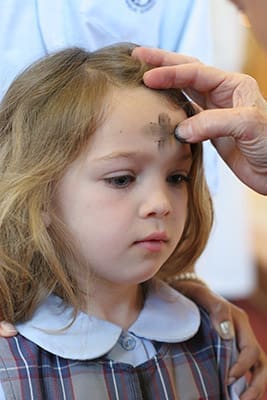 Photo By Michael Alexander
Photo By Michael AlexanderAtlanta
8 spiritual tools for families
By ANDREW NELSON, Staff Writer | Published August 29, 2013
ATLANTA—As a mother of two and a longtime leader in teaching the Catholic faith, Rosanne Bowen has tools that can help families pulled apart by today’s fast-paced world to come together.
“Mothers have always been busy, and fathers. With technology, it has filled in all the spare time,” she said. Families now have to make a greater effort to schedule time together. “We know the constraints on time.”
And just because people attend church and pray, it doesn’t make them immune from being weary, she said. “We too are part of the world that is busy.”
But Mass is a place where families can get re-energized. The spiritual tools of the faith can stir people back to life, she said.

St. Thomas More School student Lily Ryan Walker receives ashes back in 2010. Photo By Michael Alexander
“Everything we do sheds either light or darkness on our children. We have to be filled with the light so most of the time we are shedding light. That’s what we have to pass on,” said Bowen.
“No matter what your family looks like” if children see their parents living the faith, it’ll have an effect. And to parents who fear their children have left the faith, Bowen says they need to take heart.
“God works through all you have done, all that you have shown them,” she said. “We never know. Don’t ever, ever give up.”
Bowen, 68, has a long career in service to the Catholic community. She served for 18 years as the director of religious education at St. Jude School and two years at the Cathedral of Christ the King parish and school. She was one of the founding faculty members when Holy Redeemer School opened its doors in Johns Creek.
On Saturday, Aug. 24, she led a workshop on family prayer at the conference for catechists held at Transfiguration Church, Marietta. Here are Bowen’s eight tools for parents:
1. Make children aware of the faith. Is there a prayer space, nook or chair used in your home for quiet reflection? Can children see Catholic items on display? Let them see these items and feel free to ask questions and to handle the rosary, the Bible, the devotional items, and interact with these faith elements.
2. Prioritize family meals. Coming together for a meal “may not look like traditional prayer, but it is,” Bowen said. “This is sacred space. There are no computers or texts. It’s a time to be together and focus on one another.”
3. Embrace rituals and traditions. Say a prayer with children before bedtime; attend Ash Wednesday services with them; join the church community on feast days.
4. Pray devotions together. Participate in and learn about the church’s religious devotions, such as the rosary, Lenten Stations of the Cross, and many others.
5. Mark celebrations. Families can jot just about anything down in a special book or calendar, from the significant, as when a loved one dies, to daily changes, like when a child loses a tooth. As time goes by, perhaps a year later, the family can gather to remember those special moments to spur conversation and perhaps a prayer of thanksgiving.
6. Go deeper in sacramental life. Beyond Sunday Mass, there are more opportunities, like weekday Mass, the sacrament of reconciliation and adoration of the Blessed Sacrament. “We have so much we can do with our children that is life-giving,” she said.
7. Do service projects. Parents and children can do ministry together. Young children who have done this with parents are more eager to take it on as teens and adults. Also, it shows faith in action, which draws young people to the church.
8. Have faith conversations. Make it simple; ask everyone to answer the question: what was the best thing that happened today, what was the worst thing that happened? No interruptions, no questions. As children get older, allow them to ask the questions.